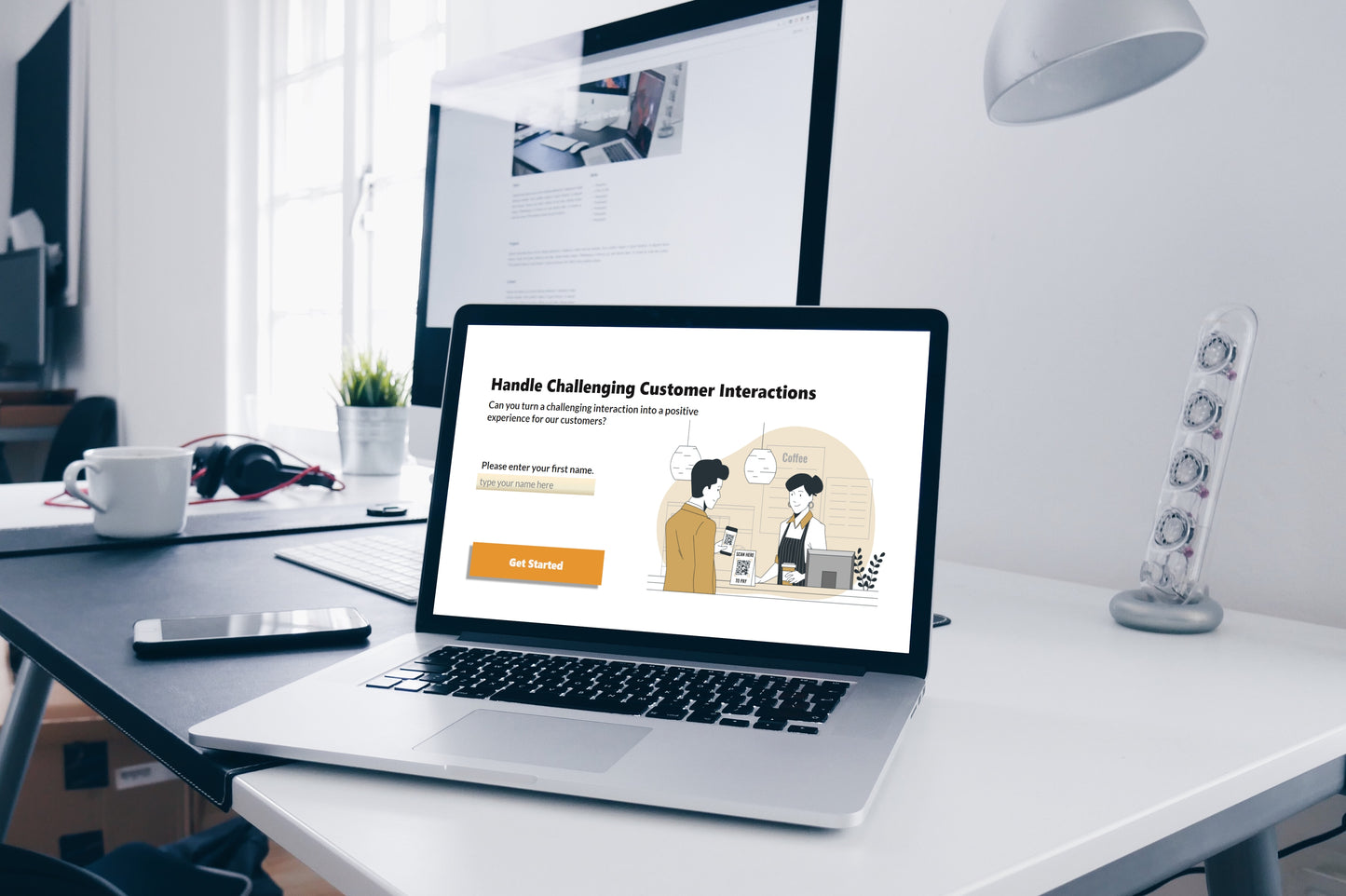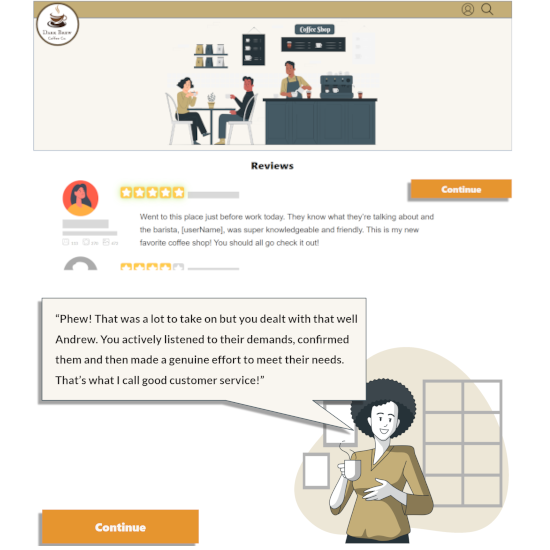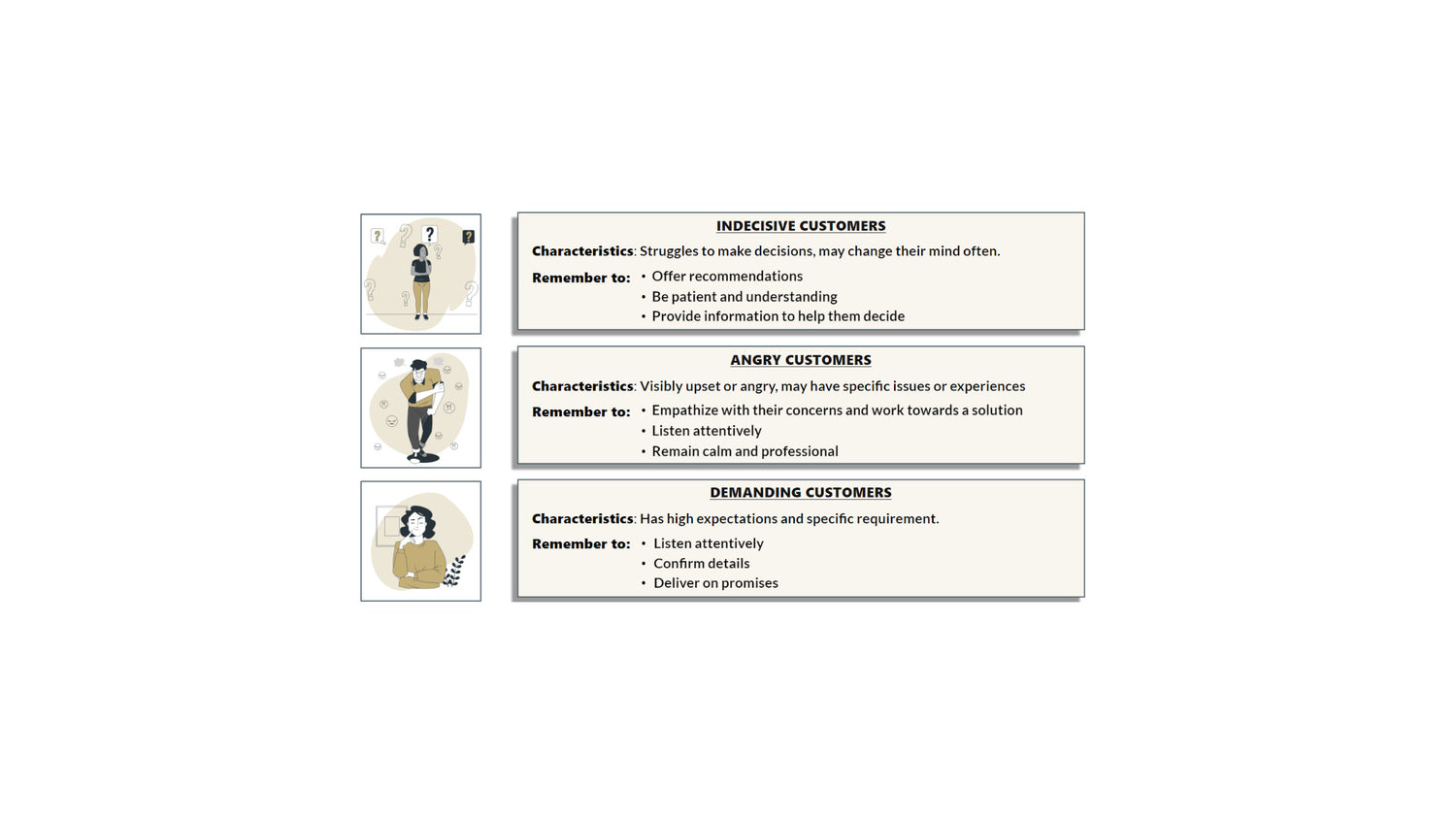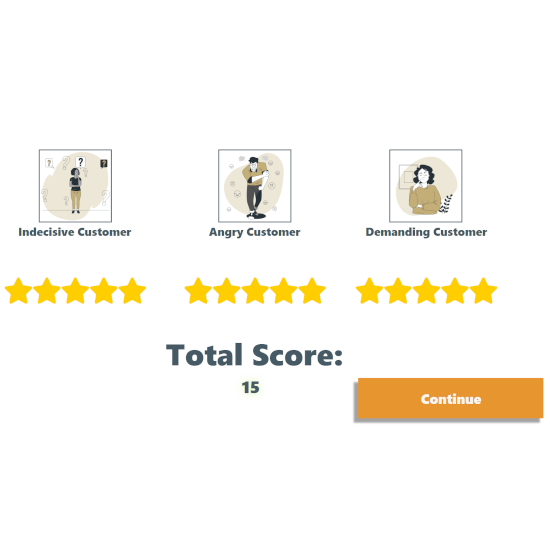articulate storyline project
Handling Challenging Customer Interactions
Handling Challenging Customer Interactions
Share

Project Overview
Audience: New and experienced baristas at Dark Brew Coffee Co.
Responsibilities: Instructional Design, eLearning Development, Visual Design, Storyboarding, Action Mapping, Prototyping.
Tools Used: Articulate Storyline, Canva, Miro, Google Suite, GIMP Image Editor, MindMeister, Storyset.com.
Intended Outcome: Improve the average customer satisfaction score by 20% (1 star) within 90 days.
Learning Objective: Staff members will demonstrate the soft skills and de-escalation tactics needed to successfully and comfortably handle a variety of challenging customer service interactions.
The Problem
This business was struggling with negative reviews online due to poor customer service experiences. The negative reviews were starting to affect the shop’s sales numbers, as well as both online and foot traffic at their brick and mortar location. The owner has noticed that the baristas and managers are specifically struggling to successfully handle the more difficult customer interactions.
The Solution
After careful analysis, I determined that the problem was not only performance related, but also a lack of knowledge and soft skills on the part of the staff. To solve both issues, I proposed an immersive scenario-based eLearning experience to allow learners to engage in low-risk, simulated customer interactions, ultimately improving their real-world performance and enhancing customer satisfaction.
Scenario-based learning immerses learners in realistic situations where they have to make decisions, fostering the development of soft skills crucial for handling challenging customers. This approach was chosen because it offers a learner-centered, interactive experience that allows baristas to practice their responses to difficult customer interactions in a safe environment.
My Process
My process for creating this eLearning training for Dark Brew Coffee Co. followed a systematic approach, primarily drawing from the ADDIE (Analysis, Design, Development, Implementation, and Evaluation) model as well as the core principles of design thinking (Empathize, Define, Ideate, Prototype, Test, Iterate.)
I began by identifying the problem, which was a lack of soft skills, poor customer service experiences, and negative reviews. I conducted a needs analysis, consulted SMEs, considered reviews, and the specific and most common challenges faced by baristas when dealing with customers.
Once I understood the problem, I formulated a specific learning objective that aligned with the business’s intended outcome of improving review ratings by 20% in 90 days. I then chose a scenario-based approach to immerse learners in realistic customer interactions.
By the end of development I had created an action map which identified key customer types and potential solutions to each, drafted a text-based storyboard and decision tree, designed visual style guides, wireframes, mockups and a prototype.
Storyboard and Action Mapping
Text-based storyboarding and action mapping played crucial roles in the development process of the course. Action mapping helped me to pinpoint the primary challenges to the intended outcome and identify the specific customer types the staff found most challenging and caused the bulk of the negative or mediocre reviews.

By breaking down the broader goal into specific actions, such as handling angry customers, accommodating demanding ones, and assisting indecisive customers, I identified the critical learning objectives. The action mapping process ensured that the content directly addressed the key knowledge and performance gaps while providing practical scenarios for learners to develop their customer service skills effectively.
The text-based storyboard, on the other hand, served as a blueprint for content organization, application of gamified elements and general flow. It provided detailed descriptions of scenarios, learner feedback and reward elements, decision trees and the scripted dialogue between learners and virtual customers. This allowed for a clear visualization of the learner's journey through the module, and ensured a logical and engaging narrative.

Visual Design
Once the storyboard had been approved by the client and I was confident I had created an engaging and learner-centered experience, I turned my attention to the visual design for the course. I aimed to align the visual design elements with the brand’s identity while also providing an aesthetically pleasing user interface.

To achieve this, I used Canva to create a style guide using carefully selected images, fonts, and colors that reflected the coffee shop's branding. These design elements were consistently applied throughout the module to create a cohesive and visually appealing look.
Next, I used Miro to create a series of wireframes and screen mockups to plan the layout and visual structure for the course.


This process helped ensure user-friendly navigation and produce visually appealing content. Overall, visual design played a significant role in enhancing the learning experience while reinforcing the coffee shop's brand identity.
Additional Features

Enhanced Learning
Strategic Feedback
Throughout the course the learner is offered guidance from a mentor, Sarah, who assists them by providing hints and an explanation for why the customer responded the way they did. This helps the learner to understand and develop the necessary skills to handle situations effectively. These behaviours are reinforced by awarding the learners review stars and motivating them to improve their customer service skills.

engaging and entertaining
Immersive Learning Experience
An immersive learning experience actively engages the learner, making the educational processs more memorable and enjoyable. This leads to improved comprehension, retention, and real-world application of the knowledge and skills taught in the course.

Performance Support
Downloadable Job Aid
A downloadable job aid is provided at the end of the course. This gives the learner a tangible resource they can reference on the job, boost their confidence, and promote continued education and reinforcement of the skills and tactics taught in the course.

Enhanced engagement and motivation
Gamification
By gamifying the experience and introducing elements of challenge and reward, the course becomes a more enjoyable, motivating and effective learning tool. Gamification in a learning experience is a key element to improving knowledge, retention and active participation in learners.
Testing and Results
I conducted final testing by having the SMEs and a small pool of learners participate by completing the scenario-based eLearning experience. I wanted every person who would interact with the learning experience to provide feedback from the learning experience.
The feedback provided from the testing helped make final adjustments to the course before it was launched. Additional feedback from the testing consisted of minor button functionality tweaks, a try again option and final adjustments to the story in the scenario.
This process ensured that the tool functioned correctly for the learners and provided a quality product. Learner scores were collected by sending a simple xAPI statement to an LRS.
Reflection
The process of creating the Handling Challenging Customer Interactions provided me with several key takeaways.
Visual Design: The process of creating some simple branding for the Dark Brew Coffee Company and aligning the company's branding colours with the colours in the learning module itself was a lot of fun. I made sure to keep the theme consistent and keep within the brand.
I made sure to use simple animations that wouldn't take away from the training or be distracting. I ensured that all the visual elements and images visually supported the questions, answers and customer feedback. I really enjoyed creating and showing a mock up of the company's review page and giving the learners a simple experience based on the customer's feedback that matched something similar to what they'd experience in real life.
Learning New Tools: This project allowed me to explore several new tools and play around with some features of tools I'd used in the past. I got to experiment with the Talent LMS interface, GIMP Image Editor, Miro Project Management Software, MindMeister and Storyset's customizable Illustrations. Additionally, I got to experiment with Javascript to create some simple xAPI statements that sent user scores and some basic behaviors to an LRS.
Gamification: This is one of my favorite skills to use on a project like this. Finding a way to delight learners, grab their attention and keep them motivated to learn more, is the key to creating engaging and enjoyable learning materials and gamification is a great way to do it. It breathed life into what could have been a simple, traditional training module. I'm excited to explore its potential in future learning experiences.
Working With SMEs: For this project, I worked with a few former baristas and customer service workers as well as a small pool of learners from a variety of different ethnicities, backgrounds and education levels. Creatively, as a learning experience designer, I loved creating custom scenes and gamified reward systems.
I found a fun challenge in introducing some light slang that a barista should expect from customers in the coffee shop's locale, without overwhelming the learners who came from different backgrounds or detracting from the educational experience. Working with SMEs to create something that gets everyone excited is probably one of my favorite things about being a Learning Experience Designer.


